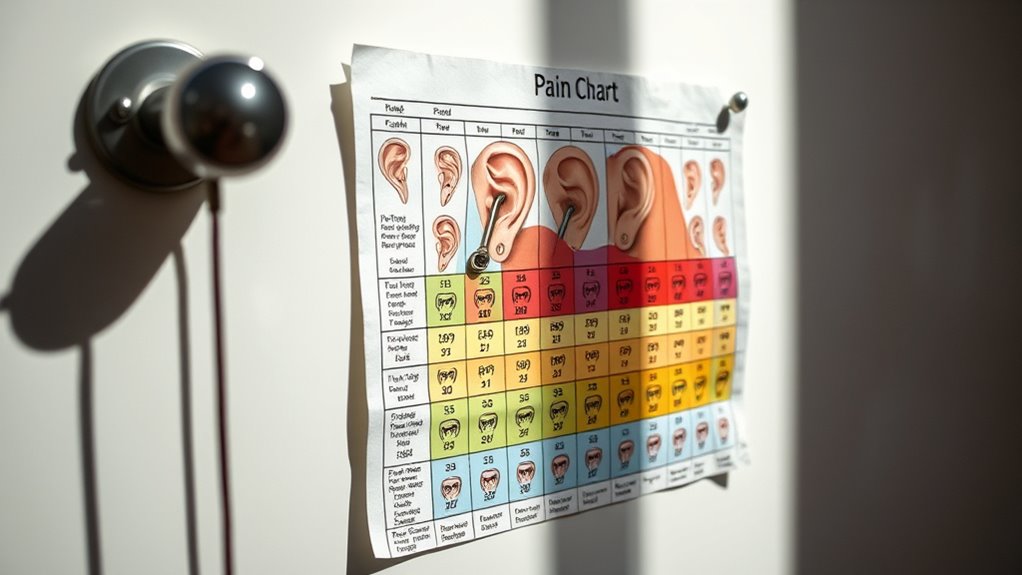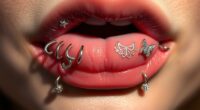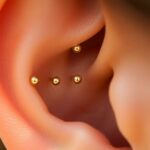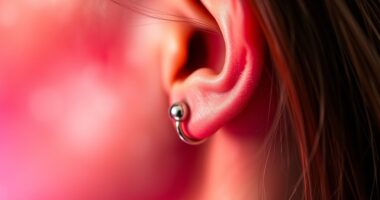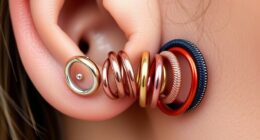Piercing pain charts show general discomfort levels across body areas based on averages, but they can be misleading because individual anatomy, nerve density, and personal pain thresholds vary widely. These charts use subjective ratings and often overlook underlying nerve complexity, so your experience might differ from what’s suggested. Keep in mind that surface appearances don’t tell the full story, and understanding these nuances can help you better prepare for your piercing journey. If you keep exploring, you’ll learn more about what influences pain perception.
Key Takeaways
- Understand that pain charts are generalized and based on averages, not individual experiences.
- Recognize that nerve density and anatomy vary, making some areas more painful than charts suggest.
- Remember that subjective pain ratings differ; a low number for one person may be high for another.
- Use charts as rough guides, but consider personal factors like anxiety, skin, and technique for accurate expectations.
- Approach charts critically, knowing they don’t capture underlying nerve complexity or individual variability.

Ever wonder how to interpret piercing pain charts accurately? Understanding these charts isn’t as straightforward as it might seem, especially if you don’t take into account anatomy considerations and pain scale interpretation. When you look at a pain chart, what you’re seeing is a generalized map that tries to depict the level of discomfort associated with piercing different body parts. But pain isn’t universal; it varies greatly based on individual anatomy, nerve density, and personal pain thresholds. Recognizing these factors helps you read the chart more critically rather than taking it at face value. For example, a spot on the chart indicating high pain might actually be less intense for you if you have thicker skin or fewer nerve endings in that area. Conversely, a seemingly mild pain zone could feel much worse if your anatomy makes that region more sensitive.
Pain scale interpretation is another key aspect to think about. Most piercing pain charts rely on a simple, often subjective, scale—say, from 1 to 10—to indicate discomfort levels. But what a 5 feels like for one person could be a 2 or a 7 for someone else. When you’re evaluating these charts, remember that they’re often based on averages or anecdotal reports, not precise measurements. Your own pain response depends not only on the area but also on your emotional state, pain tolerance, and even the equipment used. So, don’t assume that a low pain rating guarantees a completely painless experience, nor should a high rating scare you off. Instead, use the chart as a rough guide, keeping in mind that your personal experience may differ. Additionally, projector technology such as high resolution, contrast ratios, and color accuracy can influence your visual perception of images, just as anatomy influences pain perception, making some areas seem more or less sensitive than they actually are.
Another important consideration is that these charts don’t account for the complexity of anatomy beneath the surface. For instance, areas with dense nerve clusters, such as around the ears or certain parts of the face, tend to be more painful because they’re richly innervated. Conversely, regions with fewer nerve endings may seem less painful on the chart, but factors like anxiety or improper technique can amplify discomfort. Recognizing these anatomy considerations helps you understand why pain levels vary so much and why charts can sometimes be misleading. They’re helpful as a starting point, but your actual experience will depend on your body’s unique structure and your mental preparedness. By approaching piercing pain charts with a critical eye—considering anatomy and interpreting the pain scale thoughtfully—you’ll gain a clearer, more realistic picture of what to expect and avoid unnecessary anxiety.
Frequently Asked Questions
Do Pain Levels Vary Between Individuals?
You’ll find that pain levels definitely vary between individuals due to factors like pain sensitivity and cultural differences. Some people might find certain piercings more uncomfortable than others, even if the procedure is similar. Your personal pain threshold, past experiences, and cultural attitudes toward pain all influence how you perceive discomfort. So, don’t rely solely on charts; your unique response matters most. Everyone experiences pain differently, and that’s perfectly normal.
Are Pain Charts Applicable to All Piercing Types?
Did you know that pain experiences can differ by over 60% depending on the person? When considering if pain charts apply to all piercing types, remember their limitations. Pain chart limitations mean they don’t account for piercing type differences, which vary widely. While some piercings, like earlobe, tend to be less painful, others, like cartilage, can be more intense. Always consult a professional for personalized guidance.
How Do Emotional Factors Influence Pain Perception?
You might notice that emotional factors profoundly influence how you perceive piercing pain. When you have strong emotional resilience and good mental health, you tend to handle pain better, feeling less intense discomfort. Conversely, stress, anxiety, or fear can heighten pain perception. Your mental state shapes your experience, making emotional resilience a key factor in managing pain during piercings. Staying calm and positive can help you endure the process more comfortably.
Can Pain Tolerance Change Over Time?
Imagine your pain perception as a river that flows differently over time. Your pain tolerance can fluctuate due to factors like stress, emotions, or health changes. Over time, you might find you handle pain better or worse, like the river widening or narrowing. Yes, your pain tolerance can change, influenced by your body’s response, making your experience of pain a dynamic, evolving journey rather than a fixed state.
Are There Safer Alternatives to Painful Piercings?
If you’re seeking safer options than painful piercings, consider alternative methods like clip-on jewelry or temporary tattoos. These options allow you to enjoy the look without risking injury or discomfort during healing processes. Choosing less invasive alternatives helps you avoid potential complications, making your experience safer and more comfortable. Always research and consult professionals to find the best, pain-free ways to express your style safely.
Conclusion
Now that you know how to decode piercing pain charts, don’t be duped by their deceptive diagrams. Immerse yourself in data with discernment, and don’t depend solely on superficial summaries. Instead, explore experiences, evaluate explanations, and educate yourself thoroughly. By biasing your beliefs less and curiosity more, you’ll avoid misjudgments, master your measurements, and make more mindful choices. Remember, understanding isn’t just about charts—it’s about challenging assumptions and championing clarity. Stay skeptical, stay savvy!
I’m Gillian. I love piercings and tattoos- there’s something about the way they make your body look that just makes me happy. I started this blog to share my passion for piercings and tattoos with the world and to help people who are thinking of getting their first piercing or tattoo.
I’ve been writing about piercings and tattoos for a while now on piercings-body.com. I love sharing my knowledge with others and helping people make informed decisions about their bodies.

